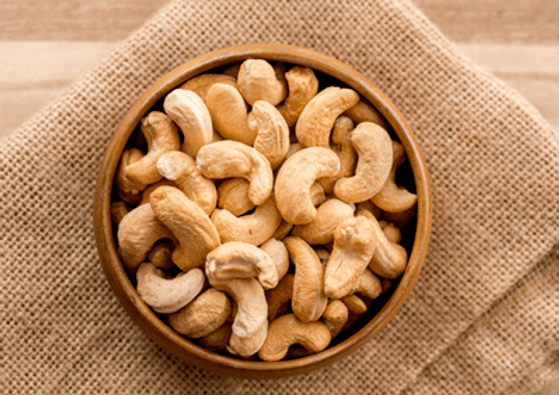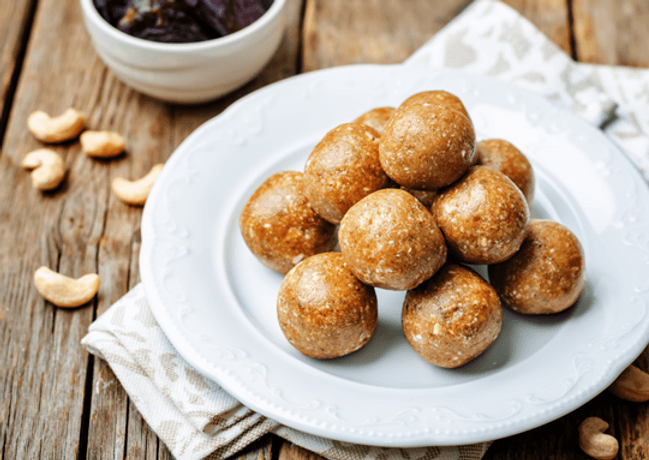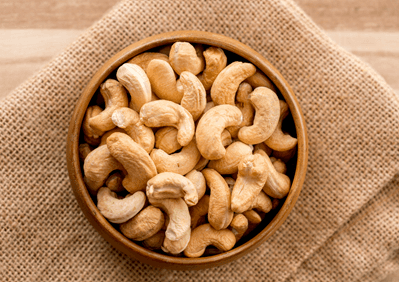The Ayurvedic Perspective on Kajutaka (Cashew nut) : History, Origin, and Classical Explanation
Its World Cashew Day. And we want to speak to you about the Ayurveda perspective, properties and its benefits. Read to know more

In Ayurveda, the comprehensive understanding of various natural ingredients underpins its rich therapeutic traditions. Among these is Kajutaka (commonly referred to as cashew nut), a potent and nutritious ingredient celebrated in recent Nighantu (Ayurvedic lexicons) for its myriad health benefits. This blog delves into the classical Ayurvedic explanation of Kajutaka, tracing its history, origin, qualities, and formulations that leverage its unique attributes for holistic well-being.
Kajutaka: History and Origin

The cashew tree (Anacardium occidentale) is native to tropical regions, primarily Brazil, and was introduced to India by Portuguese traders in the 16th century. Over time, it is introduced in Ayurvedic pharmacopeia, where its kernel (nut) and other parts were analyzed for their therapeutic properties. Though Kajutaka does not feature prominently in classical Ayurvedic texts like Charaka Samhita or Sushruta Samhita due to its later introduction, modern Nighantu have documented its medicinal relevance based on its observed effects on the body and mind.
Ayurvedic Qualities of Kajutaka
According to Ayurveda, every substance has specific Dravyaguna (properties) that determine its effects on the body.
Rasa (Taste): Madhura (sweet), slightly Kashaya (astringent).
Guna (Quality): Guru (heavy), Snigdha (unctuous).
Veerya (Potency): Ushna (hot).
Vipaka (Post-digestive effect): Madhura (sweet).
These qualities render Kajutaka nourishing, strength-enhancing (Balya), and beneficial in managing Vata disorders due to its grounding and lubricating nature. Its warming potency also helps in balancing Kapha to some extent but may aggravate Pitta if consumed excessively.
Therapeutic Applications
Nourishment and Vitality:
Kajutaka is recognized for its Ojas-enhancing properties, making it an excellent choice for individuals experiencing fatigue or debility. Its rich nutritional profile, including healthy fats and minerals, supports tissue nourishment (Dhatu Poshana)
Digestive Health:
Though heavy to digest (Guru), moderate consumption can support healthy digestion due to its lubricating nature, which soothes dryness in the digestive tract
Reproductive Health:
Kajutaka is often recommended in formulations aimed at improving reproductive health and vitality due to its ability to strengthen Shukra Dhatu (reproductive tissue)
Neurological Benefits:
Its nourishing properties benefit the nervous system, helping to alleviate dryness and weakness caused by aggravated Vata.
Skin Health:
Topical preparations using Kajutaka oil or paste are known for their moisturizing and soothing properties, beneficial for dry and irritated skin
Recipes Using Kajutaka

Kajutaka Laddoo:
A classical nourishing confection combining cashew nuts, ghee, and jaggery, prepared as a strength-enhancing recipe
Ojas-Boosting Paste:
Cashews blended with almonds, saffron, and milk form a rich paste used in rasayana therapy to rejuvenate the body
Vata-Pacifying Kheer:
Cashew nuts cooked with milk, cardamom, and a touch of ghee serve as a calming and grounding dessert to balance Vata
Modern Integration in Ayurveda
Kajutaka is a prime example of how Ayurveda adapts to incorporate newer ingredients while retaining its foundational principles. Modern Nighantu have highlighted its role in addressing lifestyle disorders, including fatigue, poor digestion, and skin ailments. Research corroborates its benefits, attributing these to its high magnesium, zinc, and antioxidant content, aligning with Ayurveda's holistic view of nourishment and health.
Precautions
While Kajutaka is beneficial, Ayurveda emphasizes moderation due to its Guru and Ushna properties. Excessive consumption can cause digestive discomfort and aggravate Pitta. It is also contraindicated for individuals prone to skin inflammation or excessive heat in the body.
Conclusion
Kajutaka represents the beauty of Ayurveda’s adaptability, blending ancient wisdom with modern insights. By understanding its properties and appropriate usage, it can be harnessed effectively in formulations and daily regimens to promote health and vitality. Whether consumed as a wholesome snack or integrated into traditional recipes, Kajutaka remains a testament to Ayurveda's timeless principles
Ever wondered, how sharp your brain really is - and if you can make it sharper ?
Nov 8, 2025
𝘏𝘦𝘳𝘦’𝘴 𝘺𝘰𝘶𝘳 𝘤𝘩𝘢𝘯𝘤𝘦 𝘵𝘰 𝘧𝘪𝘯𝘥 𝘪𝘵 𝘰𝘶𝘵 𝘸𝘩𝘪𝘭𝘦 𝘱𝘢𝘳𝘵𝘪𝘤𝘪𝘱𝘢𝘵𝘪𝘯𝘨 𝘪𝘯 𝘴𝘩𝘢𝘱𝘪𝘯𝘨 𝘵𝘩𝘦 𝘧𝘶𝘵𝘶𝘳𝘦 𝘰𝘧 𝘣𝘳𝘢𝘪𝘯‑𝘩𝘦𝘢𝘭𝘵𝘩 𝘴𝘤𝘪𝘦𝘯𝘤𝘦 𝘪𝘯 𝘐𝘯𝘥𝘪𝘢. 𝘚𝘶𝘱𝘱𝘰𝘳𝘵𝘦𝘥 𝘣𝘺 𝐏𝐫𝐚𝐭𝐢𝐤𝐬𝐡𝐚 𝐓𝐫𝐮𝐬𝐭
Read more
The Ancient Secret to Modern Wellness: Understanding Ayurveda's Definition of Health
Oct 31, 2025
In an age where modern wellness trends are evolving continuously, Ayurveda is a timeless wisdom that is often overlooked.
Read more
Beyond Pills: Reclaiming Your Health with Ayurveda's Self-Healing Wisdom
Oct 29, 2025
Want to explore how Ayurveda and Panchakarma create pathways to healing and fulfilling careers?
Watch the podcast featuring Dr. Girish Kumar and Dr. Leena Wadia on YouTube: https://youtu.be/es53lKJXxDY?si=Xz2VVH2aaG_xjVe3
Read more
Medhya Fellowship for Cognitive Wellness Propagators: Perspectives on Healthy Ageing in Ayurveda
Oct 17, 2025
Introduction:
On the occasion of Dhanwantari Jayanti, we are pleased to announce a call for applications for
joining the MEDHYA initiative as Cognitive Wellness Propagators. The program is aimed at promoting
Ayurvedic insights and clinical documentation in the field of cognitive wellness and healthy ageing.
Read more
Hand in Hand for Better Foods and a Better Future
Oct 16, 2025
Hand in Hand for Better Foods and a Better Future | The University of Trans-Disciplinary Health Sciences and Technology (TDU)
Read more
Panchakarma and the role of Diet
Oct 6, 2025
Panchakarma literally means “five actions” or “five procedures”: Vamana (therapeutic emesis), Virechana (purgation), Basti (medicated enema), Nasya (nasal cleansing), and Raktamokshana (bloodletting). These therapies are designed to cleanse the body of accumulated toxins and restore balance to the doshas (vata, pitta, kapha).
Read more









